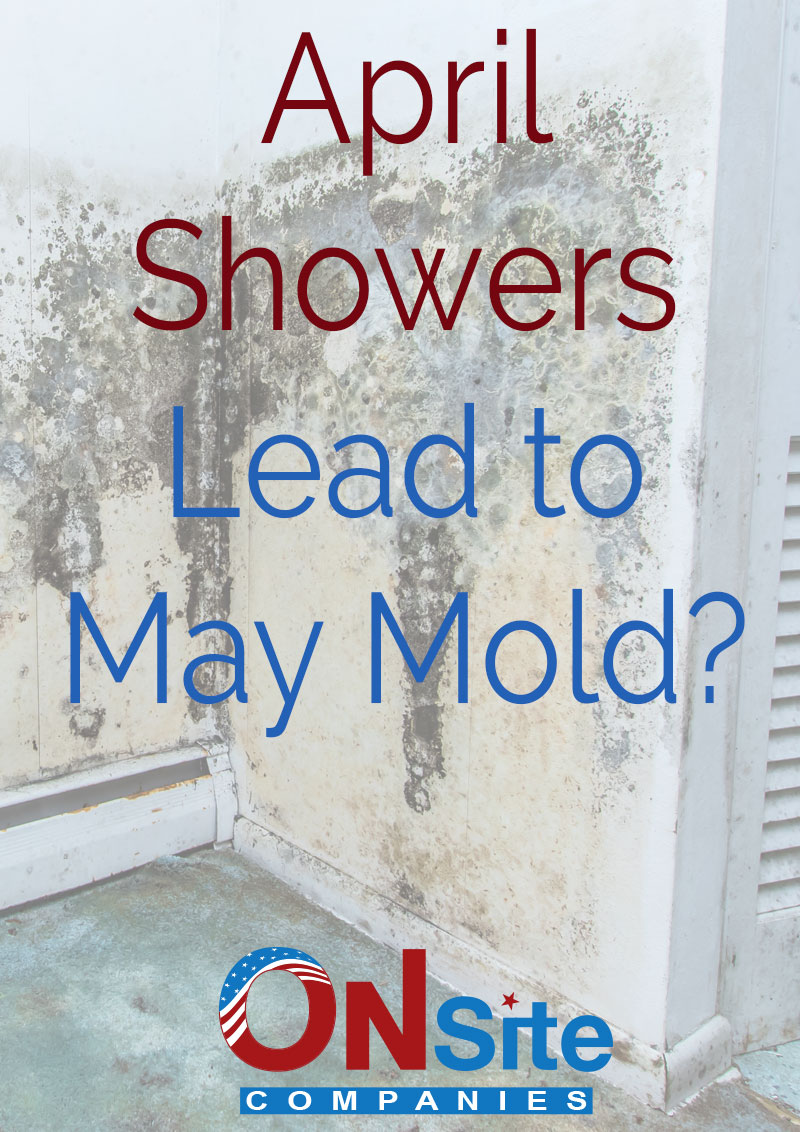The warm weather is finally here! Green grass and leafy trees are on the horizon. The world is in full bloom on the outside, but has the melting snow and rain caused something to bloom on the inside, too? It’s time to check for mold.
Even if there hasn’t been flooding, all the sudden precipitation and moisture can easily migrate from the outdoors to the indoors. It will make its way into your basement or your upper floors, coming in from the roof. In only 24-48 hours, that moisture can start growing mold or mildew. Mold is a fungal growth that develops on wet materials. That mold can spread not only where you see it, on walls, ceilings, or floors, but also through microscopic spores in the air. Those spores can also cause health issues when inhaled.

Health Issue from Mold
One of the most common effects of mold on human health is asthma developed by infants. Even if asthma is not developed, there can be a persistent cough. Prolonged exposure can lead to more issues, such as stuffiness, itchy eyes, and skin irritation.
Some mold can also be toxic. Toxic mold produces mycotoxins, which can lead to neurological problems and even death. Even after the mold is gone, mycotoxins can linger, clinging to dust particles. Again, symptoms of health issues from mycotoxins can include nasal and sinus congestion, runny nose, eye irritation, itchy, red, watery eyes, respiratory problems such as wheezing and difficulty breathing, chest tightness, cough, throat irritation, skin irritation and rashes, headache, and persistent sneezing.
Looking for Mold
At some point, it becomes obvious you have mold, but early detection can make it much easier to deal with. A simple discoloration on the ceilings or walls is the most obvious sign of mold. But even if you haven’t had any apparent signs of mold, it can still be there, hiding in small, but moist, places. If you have had any leakage or moisture, you should check any affected areas for signs of mold even after the moisture has been dealt with.
The most commonly overlooked places for mold to invade your building include behind appliances such as refrigerators or washers and dryers, behind drywall, around plumbing, carpet that was once leaked on, and inside ventilation ducts. After a winter with heaters running and snow melting, the conditions are perfect for mold to form. Mold spores can be dormant even after you’ve dried out the surfaces and come alive again months later when it gets warm.
Fortunately, there are mold-detection kits available at your local hardware store. You can test the air for mold spores with one of these kits, or you can have a professional come in and test. The professional tests will be able to tell you more information about your mold issues and start you on the road to recovery faster.
Removing Mold
Once you’ve found all the mold, you should work to remove it as quickly as possible to prevent mold spores from spreading and causing any health problems. For affected carpet and rugs, take the carpeting out of the room and place it outside. Mold, like vampires, dies in sunlight. To clean the walls and other surfaces, you will need a few supplies: a ventilator mask (to prevent inhalation of any mold spores in the air), rubber gloves, a bucket of warm water mixed with one cup of bleach, liquid disinfectant, a soft brush, some rags, and a mop. If you have wood surfaces, you’ll also need denatured alcohol to properly clean them.
Use your chlorine solution to mop the floor and clean the walls and any non-wood surfaces. Once these surfaces have dried, take the liquid disinfectant and clean the surfaces again. Repeat this process daily until the mold disappears. It may take several applications.
To clean the mold from any wooden surfaces, pour some of the denatured alcohol onto a rag to scrub. The denatured alcohol should not harm any finish on the wood, but test a small, inconspicuous spot first to be sure.
Finally, clean any cloth or upholstered items that may be potentially affected. Wash any cloth items with the hottest water the items will allow. If you can, take any upholstered items outside. Clean the upholstery with a soft brush, which will cause any mold spores to release into the air. Again, let it dry in the sunlight to kill any leftover spores.
Act Before Mold Happens
One of the easiest ways to solve your mold problem is to prevent it from happening. A dehumidifier rented from On Site Companies can help take the moisture out of the air that causes mold in so many cases. Dehumidifiers coupled with air movers can help dry an area out quickly. They’ll also ensure that mold spores in the air get filtered out. Remember when you do use a dehumidifier to make sure to empty the pan or have it set up to drain properly. Mold spores can reside in the water in a dehumidifier’s drainage.
To talk to a team member about the right dehumidification solution for you, reach out or call us today at 800-210-8407.